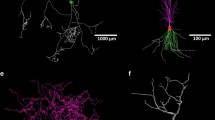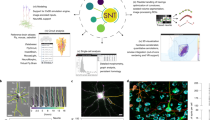Abstract
It is well established that not only electrophysiology but also morphology plays an important role in shaping the functional properties of neurons. In order to properly quantify morphological features it is first necessary to translate observational histological data into 3-dimensional geometric reconstructions of the neuronal structures. This reconstruction process, independently of being manual or (semi-)automatic, requires several preparation steps (e.g. histological processing) before data acquisition using specialized software. Unfortunately these processing steps likely produce artifacts which are then carried to the reconstruction, such as tissue shrinkage and formation of swellings. If not accounted for and corrected, these artifacts can change significantly the results from morphometric analysis and computer simulations. Here we present N3DFix, an open-source software which uses a correction algorithm to automatically find and fix swelling artifacts in neuronal reconstructions. N3DFix works as a post-processing tool and therefore can be used in either manual or (semi-)automatic reconstructions. The algorithm’s internal parameters have been defined using a “ground truth” dataset produced by a neuroanatomist, involving two complementary manual reconstruction procedures: in the first, neuronal topology was faithfully reconstructed, including all swelling artifacts; in the second procedure a meticulous correction of the artifacts was manually performed directly during neuronal tracing. The internal parameters of N3DFix were set to minimize the differences between manual amendments and the algorithm’s corrections. It is shown that the performance of N3DFix is comparable to careful manual correction of the swelling artifacts. To promote easy access and wide adoption, N3DFix is available in NEURON, Vaa3D and Py3DN.





Similar content being viewed by others
References
Aguiar, P., Sousa, M., & Szucs, P. (2013). Versatile morphometric analysis and visualization of the three-dimensional structure of neurons. Neuroinformatics, 11(4), 393–403.
Anwar, H., Riachi, I., Hill, S., Schürmann, F., & Markram, H. (2010). An approach to capturing neuron morphological diversity (pp. 211–231). Computational Modeling Methods for Neuroscientists. E. d. Schutter: The MIT Press.
Ascoli, G. A., Donohue, D. E., & Halavi, M. (2007). NeuroMorpho.Org: a central resource for neuronal morphologies. J Neurosci, 27(35), 9247–9251.
Blackman, A. V., Grabuschnig, S., Legenstein, R., & Sjostrom, P. J. (2014). A comparison of manual neuronal reconstruction from biocytin histology or 2-photon imaging: morphometry and computer modeling. Front Neuroanat, 8, 65.
Cannon, R. C., Turner, D. A., Pyapali, G. K., & Wheal, H. V. (1998). An on-line archive of reconstructed hippocampal neurons. J Neurosci Methods, 84(1–2), 49–54.
Carnevale, N. T., Tsai, K. Y., Claiborne, B. J., & Brown, T. H. (1994). The electrotonic transformation: a tool for relating neuronal form to function. Advances in neural information processing systems. G. Tesauro, D. S. Touretzky and T. K. Leen, MIT press, Cambridge. MA, 7, 69–76.
Glaser, J. R., & Glaser, E. M. (1990). Neuron imaging with Neurolucida–a PC-based system for image combining microscopy. Comput Med Imaging Graph, 14(5), 307–317.
Golding, N. L., Mickus, T. J., Katz, Y., Kath, W. L., & Spruston, N. (2005). Factors mediating powerful voltage attenuation along CA1 pyramidal neuron dendrites. J Physiol, 568(Pt 1), 69–82.
Grudt, T. J., & Perl, E. R. (2002). Correlations between neuronal morphology and electrophysiological features in the rodent superficial dorsal horn. J Physiol, 540(Pt 1), 189–207.
Halavi, M., Hamilton, K. A., Parekh, R., & Ascoli, G. A. (2012). Digital reconstructions of neuronal morphology: three decades of research trends. Front Neurosci, 6, 49.
Hines, M. L., & Carnevale, N. T. (1997). The NEURON simulation environment. Neural Comput, 9(6), 1179–1209.
Hines, M. L., Morse, T., Migliore, M., Carnevale, N. T., & Shepherd, G. M. (2004). ModelDB: a database to support computational neuroscience. J Comput Neurosci, 17(1), 7–11.
Jacobs, G., Claiborne, B., & Harris, K. (2010). Reconstruction of neuronal morphology (pp. 187–210). Computational Modeling Methods for Neuroscientists. E. d. Schutter: The MIT Press.
Jaeger, D. (2001). Accurate Reconstruction of Neuronal Morphology. In: E. d. Schutter, Computational Neuroscience: Realistic Modeling for Experimentalists. CRC Press: 159–178.
Jorgenson, L. A., Newsome, W. T., Anderson, D. J., Bargmann, C. I., Brown, E. N., Deisseroth, K., et al. (2015). The BRAIN initiative: developing technology to catalyse neuroscience discovery. Philos Trans R Soc Lond Ser B Biol Sci, 370(1668).
Krichmar, J. L., Nasuto, S. J., Scorcioni, R., Washington, S. D., & Ascoli, G. A. (2002). Effects of dendritic morphology on CA3 pyramidal cell electrophysiology: a simulation study. Brain Res, 941(1–2), 11–28.
Luz, L. L., Szucs, P., Pinho, R., & Safronov, B. V. (2010). Monosynaptic excitatory inputs to spinal lamina I anterolateral-tract-projecting neurons from neighbouring lamina I neurons. J Physiol, 588(Pt 22), 4489–4505.
Markram, H. (2012). The human brain project. Sci Am, 306(6), 50–55.
Marx, M., Gunter, R. H., Hucko, W., Radnikow, G., & Feldmeyer, D. (2012). Improved biocytin labeling and neuronal 3D reconstruction. Nat Protoc, 7(2), 394–407.
Migliore, M., Cook, E. P., Jaffe, D. B., Turner, D. A., & Johnston, D. (1995). Computer simulations of morphologically reconstructed CA3 hippocampal neurons. J Neurophysiol, 73(3), 1157–1168.
Mukherjee, S., Condron, B., & Acton, S. T. (2015). Tubularity flow field–a technique for automatic neuron segmentation. IEEE Trans Image Process, 24(1), 374–389.
Myatt, D. R., Hadlington, T., Ascoli, G. A., & Nasuto, S. J. (2012). Neuromantic - from semi-manual to semi-automatic reconstruction of neuron morphology. Front Neuroinform, 6, 4.
Peng, H., Ruan, Z., Long, F., Simpson, J. H., & Myers, E. W. (2010). V3D enables real-time 3D visualization and quantitative analysis of large-scale biological image data sets. Nat Biotechnol, 28(4), 348–353.
Peng, H., Bria, A., Zhou, Z., Iannello, G., & Long, F. (2014). Extensible visualization and analysis for multidimensional images using Vaa3D. Nat Protoc, 9(1), 193–208.
Peng, H., Hawrylycz, M., Roskams, J., Hill, S., Spruston, N., Meijering, E., et al. (2015). BigNeuron: large-scale 3D neuron reconstruction from optical microscopy images. Neuron, 87(2), 252–256.
Popko, J., Fernandes, A., Brites, D., & Lanier, L. M. (2009). Automated analysis of NeuronJ tracing data. Cytometry A, 75(4), 371–376.
Scorcioni, R., Polavaram, S., & Ascoli, G. A. (2008). L-measure: a web-accessible tool for the analysis, comparison and search of digital reconstructions of neuronal morphologies. Nat Protoc, 3(5), 866–876.
Torben-Nielsen, B. (2014). An efficient and extendable python library to analyze neuronal morphologies. Neuroinformatics, 12(4), 619–622.
Wang, Y., Narayanaswamy, A., Tsai, C. L., & Roysam, B. (2011). A broadly applicable 3-D neuron tracing method based on open-curve snake. Neuroinformatics, 9(2–3), 193–217.
Zador, A. M., Agmon-Snir, H., & Segev, I. (1995). The morphoelectrotonic transform: a graphical approach to dendritic function. J Neurosci, 15(3 Pt 1), 1669–1682.
Acknowledgments
This work was partially supported by FEDER - Fundo Europeu de Desenvolvimento Regional funds through the COMPETE 2020 - Operacional Programme for Competitiveness and Internationalisation (POCI), Portugal 2020, and by Portuguese funds through FCT - Fundação para a Ciência e a Tecnologia/ Ministério da Ciência, Tecnologia e Inovação in the framework of the project “Institute for Research and Innovation in Health Sciences” (POCI-01-0145-FEDER-007274). (ECS) was partially supported by CMUP (UID/MAT/00144/2013), which is funded by FCT (Portugal) with national (MEC) and European structural funds (FEDER), under the partnership agreement PT2020; and by the strategic programme UID/BIA/04050/2013 (POCI-01-0145-FEDER-007569) funded by national funds through the FCT I.P. and by the ERDF through the COMPETE2020 - Programa Operacional Competitividade e Internacionalização (POCI). (PSz) was partially supported by the KTIA_NAP_13-2-2014-0005 grant of the Hungarian Government, and the János Bolyai Research Scholarship of the Hungarian Academy of Sciences.
The work presented here received support and was potentiated by the BigNeuron hackathons (Peng, Hawrylycz et al. 2015). The authors would like to thank Xiaoxiao Liu and Zhi Zhou for help in the integration of N3DFix plugin in Vaa3D.
Author information
Authors and Affiliations
Corresponding author
Rights and permissions
About this article
Cite this article
Conde-Sousa, E., Szücs, P., Peng, H. et al. N3DFix: an Algorithm for Automatic Removal of Swelling Artifacts in Neuronal Reconstructions. Neuroinform 15, 5–12 (2017). https://doi.org/10.1007/s12021-016-9308-7
Published:
Issue Date:
DOI: https://doi.org/10.1007/s12021-016-9308-7




